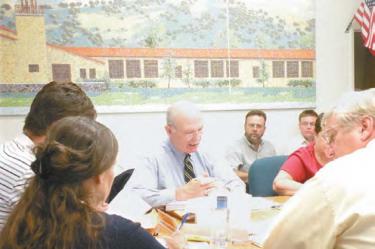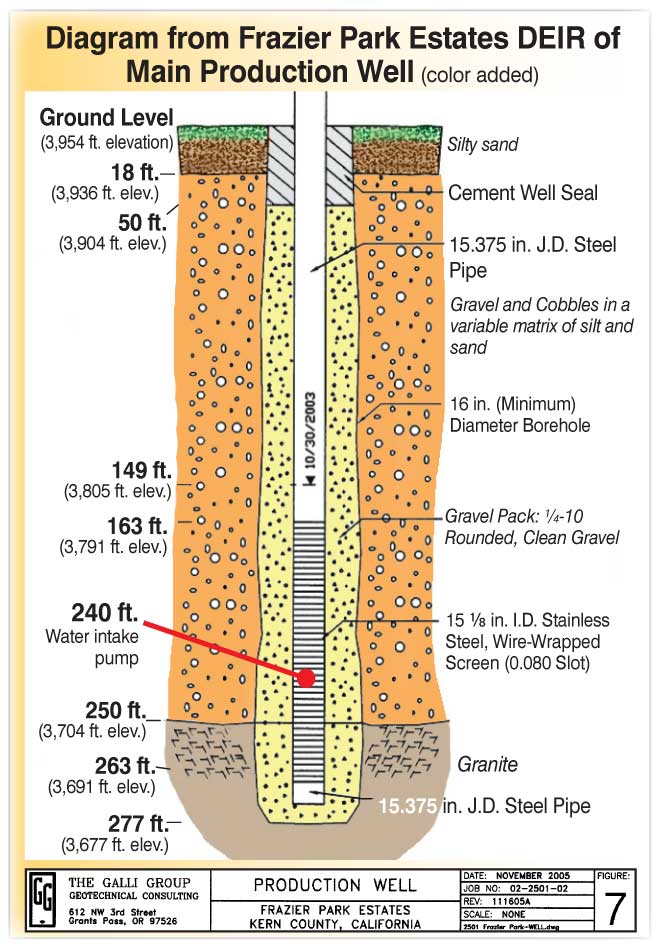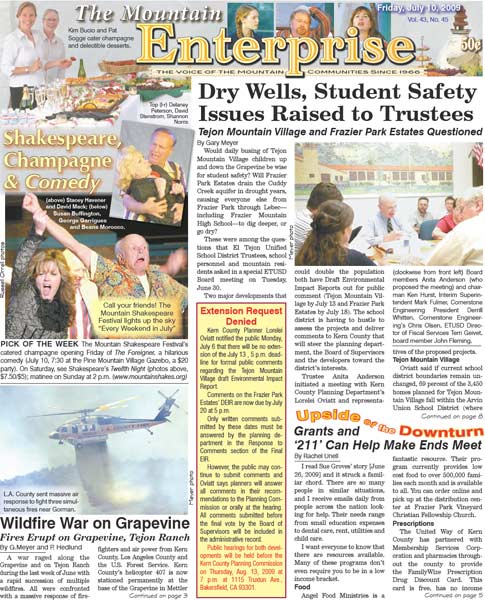
(clockwise from front left) Board members Anita Anderson (who proposed the meeting) and chairman Ken Hurst, Interim Superintendent Mark Fulmer, Cornerstone Engineering President Derrill Whitten, Cornerstone Engineering?s Chris Olsen, ETUSD Director of Fiscal Services Terri Geivet, board member John Fleming.
Tejon Mountain Village and Frazier Park Estates Questioned
Click to view PDF of chart or view image below
By Gary Meyer
Would daily busing of Tejon Mountain Village children up and down the Grapevine be wise for student safety? Will Frazier Park Estates drain the Cuddy Creek aquifer in drought years, causing everyone else from Frazier Park through Lebec—including Frazier Mountain High School—to dig deeper, or go dry?
These were among the questions that El Tejon Unified School District Trustees, school personnel and mountain residents asked in a special ETUSD Board meeting on Tuesday, June 30.
Two major developments that could double the population both have Draft Environmental Impact Reports out for public comment (Tejon Mountain Village by July 13 and Frazier Park Estates by July 18). The school district is having to hustle to assess the projects and deliver comments to Kern County that will steer the planning department, the Board of Supervisors and the developers toward the district’s interests.
Trustee Anita Anderson initiated a meeting with Kern County Planning Department’s Lorelei Oviatt and representatives of the proposed projects.
Tejon Mountain Village
Oviatt said if current school district boundaries remain unchanged, 69 percent of the 3,450 homes planned for Tejon Mountain Village fall within the Arvin Union School District (where schools are down the Grapevine section of Interstate 5 and east on Highway 223, about 45 miles away). By contrast, ETUSD schools sit virtually at the doorstep of the projected development. But under the current plan, ETUSD would not receive funding to expand facilities for students who are likely to prefer to get their education closer to home.
Oviatt’s overview of the TMV project cited 3,450 dwelling units [over 10,000 people] and 510,000 square feet of commercial space, which the developer estimates would be completed over 20 to 30 years (about the time it took to build out Pine Mountain, conceived as summer homes, now year-round family homes). Oviatt explained planners assume, on average, all households will have a schoolaged child. Currently, 1,065 of the dwelling units are within the ETUSD boundary—a northsouth line running through the middle of the project area.
Oviatt said, “This is really for the school districts to discuss and decide among themselves.” She said the districts should develop their own scenario, but offered three examples:
1) Arvin/Kern and El Tejon school districts can each take the students within their existing districts;
2) All students within the project area can go to ETUSD schools;
3) All students within the project area can go to Arvin/Kern schools.
If all students attended ETUSD schools, enrollment would increase from the current 1,209 students to 4,383 students at build-out.
Trustee John Fleming said he fears that another scenario—in which K-8 students go to Arvin/ Kern and 9-12 students go to ETUSD—would be undesirable for all involved. Trustee Anderson said she doubts wealthy families who live in TMV would be interested in busing their kids off to school in Arvin, known to have the worst air pollution in the nation.
The most provocative fact raised during the evening by audience member John Kelly and ETUSD’s Fiscal Services Director Terri Geivet, was the tale of how funding was obtained to build Frazier Mountain High School in the early 1990s.
State school construction funds were allocated after state officials, according to Geivet, decided that busing kids up and down the Grapevine was too dangerous. Funding for the project was expedited in an effort to avoid accidents involving students on buses, she said. Student health and safety issues may influence discussions between the two school districts within the TMV development area.
Among many issues at stake in ETUSD’s decision about whether to support the TMV project is the potential for receiving over $25 million in developer fees—money that could be used to build additional facilities to meet the expanding population and other impacts from the proposed development. Additionally, the district would receive an increase in its property tax revenue.
Frazier Park Estates
Fallingstar Homes has resubmitted its proposal, now hoping to build between 630 and 662 homes and 41 apartments in Lebec surrounding Frazier Mountain High School, extending north to Frazier Mountain Park Road (for about 2,100 people, including 700 children). The project would include 97,475 square feet of commercial space, a 7.5 acre park, a wastewater treatment plant and infrastructure, including drainage basins.
At the meeting, the developer suggested that by incorporating a drainage basin in the Frazier Park Estates project, the high school’s existing drainage basin could be reclaimed to build another school or for other use.
The school district could potentially receive about $5 million in developer fees plus ongoing tax revenue if the project is approved and built.
Trustee Anderson asked what would happen if the developer’s blasting activity caused hairline fractures in the high school’s concrete structures. Derrill Whitten, president of Cornerstone Engineering (representing the developer) said the blasting would be barely noticeable, but did not answer the question directly.
Kern County Planning Department first submitted FPE to the public in 2006, There was a large number of public comments. Doug Peters, a resource manager living locally, gathered and presented data in The Mountain Enterprise showing the water table at the high school’s well, located next to the developer’s well, had dropped 60 feet over the 11 years from 1992 to 2003, which were mostly high-rainfall years.
The Kern County Planning Department said public comments had raised “substantial new information,” and sent the report back to the developer for a rewrite in April 2006.
During September 2007, Peters found the water table at the high school well had fallen 80 feet, to 143 feet, in the 18 months following the winter of 2005-2006, a very high-rainfall season. He said 2,000 acre feet a year being pumped by Tejon Ranch to keep Tejon / Castac Lake full is part of the reason.
Mark Fulmer, ETUSD’s Interim Superintendent, said the water table at the high school’s well is now down to 150 feet below the surface.
Oviatt put a positive spin on water supply projections for Frazier Park Estates, saying the project would demand 545 acre feet per year, while the project plus all other community uses would demand 1,704 acre feet per year. She then stated, “At the end of a seven year drought, the Cuddy Canyon Groundwater Basin would retain 9,500 acre feet of water.”
The numbers, that sounded reassuring at first, were balanced only when board President Ken Hurst, a geologist, asked, “What would be the depth of the water table with 9,500 acre feet remaining?”
Oviatt responded, “The water level could be 90 to 260 feet [down], so you may need to drill your well deeper.” [Diagrams of the FPE well in its own report show it sits above granite bedrock, making further drilling expensive and possibly unproductive, resource manager Doug Peters said Friday, July 3.—Editor]
At the close of the meeting, Board president Hurst said, “Mark [Fulmer] and I will put together some drafts of CEQA comments on both projects for the board members to consider at our July 8 meeting.”
Public Comment Closing
The public comment period ends July 13 for TMV and July 20 for FPE. Combined, the two pose a hurdle of about 26,000 pages for residents to research with just a few days left to submit comments, but it is possible to access just the data in areas of specific interest (water, air, light pollution, etc.).
Copies of the documents are now available at the Frazier Park Branch of the Kern County Library (during regular hours) and at The Mountain Enterprise office (call 245-3794 to arrange to review the documents seven days a week and in evening hours).
According to Lorelei Oviatt, “written responses to those comments received after the July 13 deadline would not be responded to within the Response to Comments of the Final EIR.”
However, Oviatt said in an email July 6 that the public is free to continue submitting comments up until the final vote of the Board of Supervisors to certify the final EIR.
“All [public] comments will be provided to the Planning Commission and Board of Supervisors,” she wrote, adding that the planning staff will answer such comments in written form in the staff recommendations to the commission or orally at the August 13 hearing. A transcript is made of that proceeding she said.
All of this information is made part of “the administrative record [which] includes all documents and reports submitted to the planning department by the public and provided to the Planning Commission and Board of Supervisors,” Oviatt concluded. The data within the administrative record is also the basis upon which legal challenges to the county’s actions can be filed and tried in court.

This is part of the July 10, 2009 online edition of The Mountain Enterprise.
Have an opinion on this matter? We'd like to hear from you.


